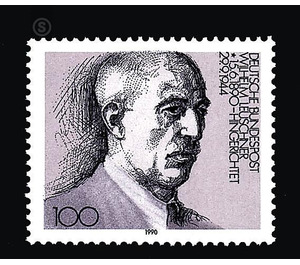100th birthday of Wilhelm Leuschner - Germany / Federal Republic of Germany 1990 - 100 Pfennig
Theme: Calender
| Country | Germany / Federal Republic of Germany |
| Issue Date | 1990 |
| Face Value | 100.00 |
| Color | grey |
| Perforation | K 14:13 3/4 |
| Printing Type | combined intaglio and offset printing |
| Stamp Type | Postage stamp |
| Item Type | Stamp |
| Chronological Issue Number | 1339 |
| Chronological Chapter | GER-BRD |
| SID | 305616 |
| In 49 Wishlists | |
Wilhelm Leuschner was born on June 15, 1890 in Bayreuth. He learned the profession of wood sculptor, studied for one semester at the Nuremberg Academy of Fine Arts and came to Darmstadt at the age of 19. Here he found work at the farm furniture factory Julius Glückert. A year later he married Elisabeth Batz. The marriage came from the son Wilhelm and the daughter Kathe. Leuschner joined the trade union movement and the Social Democratic Party. Material betterment and education appeared to him as a suitable means to reduce existing injustices of that time. As district leader of his union, he concluded the first collective agreements, which brought numerous labor and social policy improvements. At the same time he strove to expand the training of workers. The war 1914-1918 he experienced as a soldier at the front. In the post-war years, he reorganized the trade union movement in the district of Darmstadt, in parallel, he increased his work for the SPD: 1919 city council, 1920 representatives in the Provincial Committee, 1924 Hessian Member of Parliament. After the People's Chamber elections in the fall of 1927 Leuschner was in February 1928 Hessian Interior Minister. His tenure was marked by a variety of reformist initiatives in the early years. With the rise of the NSDAP began an increasingly hopeless fight against the enemies of democracy. The attacks directed against his person endangered Leuschner's position. In the fall of 1932 he moved to Berlin, where he was elected to the Federal Executive of the ADGB in January 1933. The news of Hitler's seizure of power on January 30 reached him as a delegate to a conference for an international working-time agreement in Geneva. The Reichstag fire on February 27, 1933 was a welcome occasion for the National Socialists to further oppress opposition forces. After a few days in the hands of the SA, Wilhelm Leuschner was released on 5 May 1933. The new rulers sought to use his reputation at the International Labor Conference in Geneva. However, since Leuschner did not allow himself to be misused as a compliant tool, Reichsorganisationleiter Robert Ley, who had "taken over" the unions into the German labor front, threatened him with another arrest in Germany. Against the advice of friends Leuschner nevertheless decided to return. In Freiburg, he turned to the state police, because they had arrested in his place due to a confusion another traveler. It began an almost one-year "protective custody", which led over Darmstadt, the penitentiary at Butzbach, one of the Emsland camps to the notorious Lichtenburg at Torgau. Back at liberty, Leuschner took part in a small factory for teapot accessories in Berlin and organized the sales network. His extensive travel enabled him to get in touch with his friends. The exploitation of a patent for the hard chrome plating of aluminum was the interest of the Navy, which in turn caused some protection against further reenactment. Until mid-1944, Leuschner traveled through Germany, weaving the threads of resistance. With like-minded people, regardless of their political, confessional and social background, he was in agreement with the resolute rejection and fight against the National Socialist regime. Convinced that this ideology must suffer a long-term defeat, agreed with Jakob Kaiser Leuschner for the post-war period, a federation of German industrial unions, which became a reality with the founding of the DGB after 1945. After the failed assassination of July 20, 1944 Leuschner was arrested on charges of denunciation. On September 8, he stood in front of the »People's Court« together with Karl Goerdeler, Josef Wirmer, Ulrich von Hassel and Paul Lejeune-Jung. On September 29, he was executed by hanging in Plötzensee. The last warning before his death was: "Unity!" In 1964, the Hessian Prime Minister honored his work with the creation of the Wilhelm Leuschner Medal as the country's highest honor. (Text: Hessian State Chancellery, Wiesbaden)


